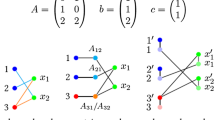Abstract
In this paper we examine the impact of using the Sherali–Adams procedure on highly symmetric integer programming problems. Linear relaxations of the extended formulations generated by Sherali–Adams can be very large, containing \(O\left( \left( {\begin{array}{c}n\\ d\end{array}}\right) \right) \) many variables for the level-\(d\) closure. When large amounts of symmetry are present in the problem instance however, the symmetry can be used to generate a much smaller linear program that has an identical objective value. We demonstrate this by computing the bound associated with the level 1, 2, and 3 relaxations of several highly symmetric binary integer programming problems. We also present a class of constraints, called counting constraints, that further improves the bound, and in some cases provides a tight formulation. A major advantage of the Sherali–Adams formulation over the traditional formulation is that symmetry-breaking constraints can be more efficiently implemented. We show that using the Sherali–Adams formulation in conjunction with the symmetry breaking tool isomorphism pruning can lead to the pruning of more nodes early on in the branch-and-bound process.




Similar content being viewed by others
References
Adams, W., Guignard, M., Hahn, P., Hightower, W.: A level-2 reformulationlinearization technique bound for the quadratic assignment problem. Eur. J. Oper. Res. 180(3), 983–996 (2007)
Applegate, D., Cook, W., Dash, S., Espinoza, D.: QSopt ex. http://www.dii.uchile.cl/daespino/ESolverdoc/main.html (2007). Accessed 7 Oct 2012
Balas, E., Saxena, A.: Optimizing over the split closure. Math. Program. Ser. B 113(2), 219–240 (2008)
Bödi, R., Herr, K., Joswig, M.: Algorithms for highly symmetric linear and integer programs. Math. Program. 137, 1–26 (2011)
Bonami, P., Minoux, M.: Using rank-1 lift-and-project closures to generate cuts for 0–1 mips, a computational investigation. Discrete Optim. 2(4), 288–307 (2005)
Darga, P.T., Liffiton, M.H., Sakallah, K.A and Markov, I.L.: Exploiting structure in symmetry detection for CNF. In: Design Automation Conference (DAC), pp. 530–534 (2004)
De Klerk, E., Maharry, J., Pasechnik, D.V., Richter, B., Salazar, G.: Improved bounds for the crossing numbers of km, n and kn. SIAM J. Discrete Math. 20, 189–202 (2006)
De Klerk, E., Pasechnik, D.V., Schrijver, A.: Reduction of symmetric semidefinite programs using the regular *-representation. Math. Program. B 109(2–3), 613–624 (2007)
De Klerk, E., Sotirov, R.: Exploiting group symmetry in semidefinite programming relaxations of the quadratic assignment problem. Math. Program. Ser. B 122(2), 225–246 (2010)
Fischetti, M., Lodi, A.: Optimizing over the first chvátal closure. Math. Program. Ser. B 110(1), 3–20 (2007)
Fischetti, M., Lodi, A., Tramontani, A.: On the separation of disjunctive cuts. Math. Program. 128, 205–230 (2011)
Fulkerson, D.R., Nemhauser, G.L., Trotter, L.E.: Two computationally difficult set covering problems that arise in computing the 1-width of incidence matrices of Steiner triples. Math. Program. Study 2, 72–81 (1974)
Gatermann, K., Parrilo, P.: Symmetry groups, semidefinite programs, and sums of squares. Pure Appl. Alg. 192, 95–128 (2004)
Ghoniem, A., Sherali, H.: Defeating symmetry in combinatorial optimization via objective perturbations and hierarchical constraints. IIE Trans. 43(8), 575–588 (2011)
Hahn, P.M., Zhu, Y.-R., Guignard, M., Hightower, W.L., Saltzman, M.J.: A level-3 reformulation-linearization technique-based bound for the quadratic assignment problem. INFORMS J. Computi. 24(4), 202–209 (2012). (spring)
Hämäläinen, H., Honkala, I., Litsyn, S., Östergård, P.: Football pools-a game for mathematicians. Am. Math. Mon. 102(7), 579–588 (1995)
Kaibel, V., Peinhardt, M., Pfetsch, M.E.: Orbitopal fixing. In IPCO 2007: The Twelfth Conference on Integer Programming and Combinatorial Optimization. pp. 74–88. Springer (2007)
Liberti, L.: Reformulations in mathematical programming: automatic symmetry detection and exploitation. Math. Program. 131, 273–304 (2012)
Linderoth, J., Margot, F., Thain, G.: Improving bounds on the football pool problem via symmetry reduction and high-throughput computing. INFORMS J. Comput. 21, 445–457 (2009)
Litsyn, S.: An updated table of the best binary codes known. In: Pless, V.S., Huffman, W.C. (eds.) Handbook of Coding Theory. volume 1, pp. 463–498. Elsevier, Amsterdam (1998)
Luks, E.M.: Permutation groups and polynomial-time computation. In: Larry, F., William, M.K. (eds.) Groups and Computation, Volume 11 of American Mathematical Society, DIMACS Series. pp. 139–175, (DIMACS, 1991) (1993)
Margot, F.: Pruning by isomorphism in branch-and-cut. Math. Program. 94, 71–90 (2002)
Margot, F.: Exploiting orbits in symmetric ILP. Math. Program. Ser. B 98, 3–21 (2003)
McKay, B.D.: Nauty User’s Guide (Version 1.5). Australian National University, Canberra (2002)
Mills, W.H., Mullin, R.C.: Coverings and packings. In: Dinitz, J.H., Stinson, D.R. (eds.) Contemporary Design Theory: A Collection of Surveys, pp. 371–399. Wiley, New York (1992)
Östergård, P., Wassermann, A.: A new lower bound for the football pool problem for six matches. J. Comb. Theory Ser. A 99(1), 175–179 (2002)
Ostrowski, J.: Symmetry handling in mixed-integer programming. In: Cochran, J., Cox, L., Keskinocak, P., Kharoufeh, J., Smith, C. (eds.) Wiley Encyclopedia of Operations Research and Management Science. Wiley (2010)
Ostrowski, J., Linderoth, J., Rossi, F., Smriglio, S.: Orbital branching. Math. Program. 126, 147–178 (2011)
Ostrowski, J., Linderoth, J., Rossi, F., Smriglio, S.: Solving large steiner triple covering problems. Oper. Res. Lett. 39(2), 127–131 (2011)
Sherali, H., Adams, W.: A hierarchy of relaxations between the continuous and convex hull representations for zero-one programming problems. SIAM J. Discrete Math. 3(3), 411–430 (1990)
Sherali, H., Smith, C.: Improving discrete model representations via symmetry considerations. Manage. Sci. 47, 1396–1407 (2001)
Shrijver, A.: New code upper bounds from the Terwilliger algebra. IEEE Trans. Inf. Theory 51, 2859–2866 (2005)
Wille, L.T.: The football pool problem for 6 matches: A new upper bound obtained by simulated annealing. J. Comb. Theory Ser. A 45(2), 171–177 (1987)
Zanette, A., Fischetti, M., Balas, E.: Lexicography and degeneracy: can a pure cutting plane algorithm work? Math. Program. 130, 153–176 (2011)
Acknowledgments
The author would like to thank Ricardo Fukasawa, Jeff Linderoth, Sven Leyffer, and the anonymous referees for their helpful comments about this work.
Author information
Authors and Affiliations
Corresponding author
Rights and permissions
About this article
Cite this article
Ostrowski, J. Using symmetry to optimize over the Sherali–Adams relaxation. Math. Prog. Comp. 6, 405–428 (2014). https://doi.org/10.1007/s12532-014-0072-0
Received:
Accepted:
Published:
Issue Date:
DOI: https://doi.org/10.1007/s12532-014-0072-0




